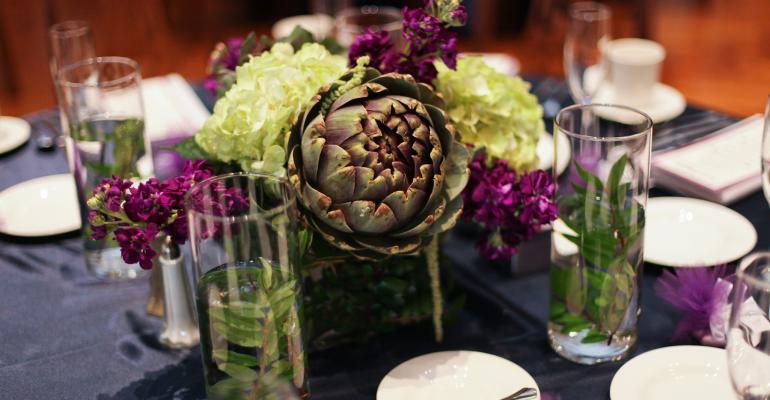A SUCKER FOR SUCCULENTS The popularity of succulents with home gardeners has had a clear impact on centerpiece design. Beautiful and sustainable, succulents are finding a place at the table, especially when paired with eco-themed containers and decor elements.
“We do a lot of tabletop succulent gardens in sustainable, reusable containers such as driftwood and bark,” says Dana Beatty, director of floral/horticulture for Venetian/Palazzo Hotels, Las Vegas. Assorted grasses and long-lasting flowers, such as cymbidium orchids and bromeliads, add color and texture. “Succulents are definitely cool-looking,” adds David McKnight, owner of Farmington, Mich.-based Emerald City Designs. “And we can keep them growing in our studio and rotate them in and out of floral pieces, almost like a rental item.”
McKnight favors multihued varieties of echeveria, and adds an ethereal element to the succulent mix with tillandsia, an air plant in the bromeliad family. “Typically, we are incorporating other floral varieties and foliage into our succulent designs, such as Dusty Miller, brunia, pincushion proteas and dahlias, to name a few.” Grape wood and fresh herbs such as lavender, rosemary and mint geranium add both textural and sensual elements without upping to cost too much.
Homage to Foliage
In keeping with the green theme—literally and figuratively—foliage-focused centerpieces are topping tables to great success. “As a cost-saving alternative, we do foliage-only centerpieces,” Beatty says. Her current go-to: magnolia foliage. She explains, “With its rich green and brown leaves, it complements a lot of color palettes.” Another favorite: date palm fronds, for both aesthetic and altruistic reasons. “We are currently using date palms in everything; they are architecturally interesting, long-lasting and create a very organic design,” she says. “Additionally, the trees here in Las Vegas were recently trimmed to remove the dates in an effort to reduce the interest of birds, so the best part is we are both recycling yard waste and reducing the amount of green waste we create.”
Nancy Kitchen, AIFD, president of The Flower Loft in Rahway, N.J., finds that foliage fares best when approached organically, with reclaimed textiles, minerals and found objects incorporated into the design. “In these designs, the connection to nature dominates, with foliage the central element with its clean, sculptural lines,” says Kitchen, who favors the look of green and brown Crocosmia pods on tall stems with straight or draping lines. “For a fresh variation to the foliage palette of green and brown, purple floral adds an elegant dash of color,” she says.
Kitchen recently created a foliage-focused head table using a rustic farm table set with a runner topped with clusters of mini green landscapes coursing down the center. “I used simple materials—branches, grasses, foliage, stones, moss and just a few small jewel-like flowers with some 6-foot foliage branches soaring up,” she explains. The surprise underneath the table: long clusters of roots taped directly under the tall branches, lit with LEDs. “When using non-floral elements in centerpieces, a decision must be made to allow either florals or non-florals to dominate the design,” cautions Kitchen “Equal parts can look indecisive.”
Flower Power
In the midst of all this green, however, flowers—currently, the more vibrantly-hued the better, per Kitchen—will always be central to centerpiece design. Lilies, double- and triple-petaled in medium pinks and bright whites, as well as coral-hued gloriosas, huge, open-cut ranunculus, purple-hued Florigene carnations and, of course, ruffled, cabbage and garden roses in all shades are some of her current standbys.
As for colors, Kitchen advocates bold and bright. “Think cerise pink, blazing yellow, purple, chartreuse, coral and watermelon,” says Kitchen, who currently favors “a combination of verdigris and turquoise, with splashes of pomegranate or rose red—a color palette reminiscent of Tibetan turquoise and coral jewelry.”
Both Kitchen and Beatty suggest grouping for dramatic looks. “We do solid combinations of greenery, seeds, mosses, flowers and grasses,” Beatty says. Kitchen suggests individual stems of linear clusters of flowers in an eclectic collection of vases. “Use interestingly shaped, small- to medium-sized containers, placed on a base, such as metal, cork or a slab of wood, to unify the design,” she suggests.
ALL AGLOW Just as flowers and foliage are essential to the centerpiece, a table simply would not be complete without candlelight. “We have been using a lot of mercury glass with either floating candles or tea lights in our designs,” McKnight says. “Occasionally, we have clients who want mostly candlelight with just a touch of floral. We achieve this by submerging plant materials such as rose petals and greenery into vases, then then topping them with floating candles.”
Kitchen achieves a romantic glow on her tables with a combination of candles, mirrors and flowers. A framed mirror is placed on blocks of damp floral foam into which hydrangea blooms are tucked, peeking out around the sides of the mirror. (“Cutting apart the hydrangea blooms stretches the coverage,” she advises.) A collection of glass candlesticks, pillar candles in glass bubble balls, and crystal balls lit with LEDs complete the look.
Branding Bouquets
“I love the idea of branding in centerpiece design, and there is a subtle way to do this without taking away from the art of the centerpiece,” says McKnight, whose preferred mode of brand boasting is through versatile vellum paper onto which corporate logos or couple’s names are printed. “We wrap the customized vellum paper around clear glass cylinder vases and light them with floating candles, votives or LEDs,” he says.
Beatty encourages her clients to use the centerpieces as modes of transport of the corporate brand. “We recently created carnation topiary balls in the colors of the client’s logo,” she says, adding that staking a client’s logo into a low profile centerpiece is another easy option.
“It is not enough in the business world for centerpieces to just look great,” Kitchen adds. “Corporate planners get extra mileage from their event budget when the centerpiece reinforces a marketing message or mission statement with visual references to the theme by using corporate colors, graphics, images and logos within the designs.”





